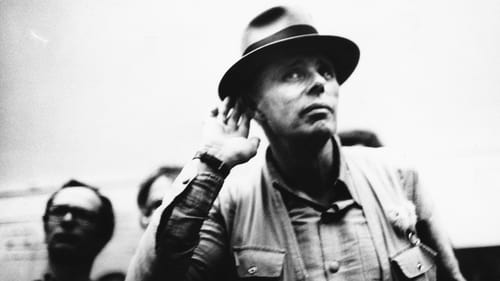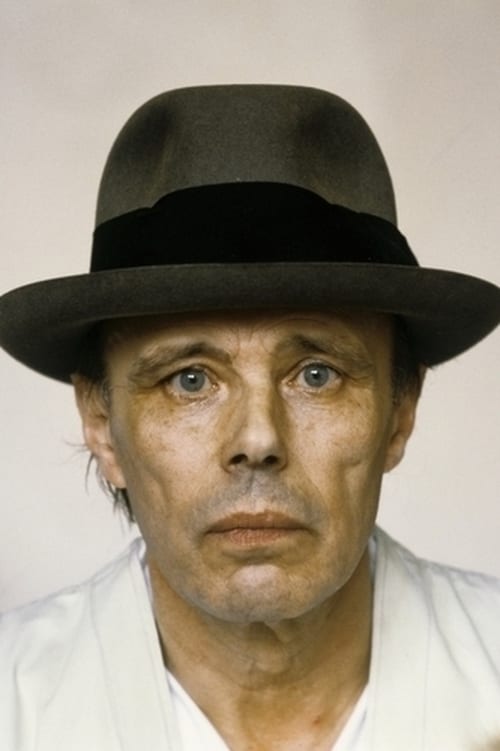Joseph Beuys
Рождение : 1921-05-12, Krefeld, Germany
Смерть : 1986-01-23
История
Joseph Beuys was a German artist, theorist and teacher who was highly influential in international contemporary art in the latter half of the 20th century. He is a founder of the art movement known as Fluxus, and a practitioner and exemplar of happenings, and performance art.

Self (archive footage)
История основоположника видеоарта, который скрестил дзен с новыми технологиями и предвосхитил современную цифровую культуру.

Self - Artist (archive footage)
The amazing story of electronic music: its epic journey from its origins in Europe, at the hands of the great artists of the post-war classical avant-garde, to the great post-industrial cities of the USA, where this genre of genres took over music stores, shady clubs and, eventually, the big stages.

Himself (archive footage)
A documentary about the 20th century German sculptor and performance artist Joseph Beuys.

“Drawing on his personal archives, Mekas has assembled a Fluxus vaudeville starring Yoko Ono, Joseph Beuys, and the late Nam June Paik. Most of the material is relatively recent although Ben Vautieur shows some early 1960s work to hilarious effect and Mekas channels Fluxus founder George Maciunas throughout.” – J. Hoberman, VILLAGE VOICE

Writer
Семь перформансов классиков жанра, созданных в 1960-е и 1970-е и «реанимированные» Мариной Абрамович по причине их плохой задокументированности. Желая избежать ошибок прошлого, Абрамович на сей раз дотошно и скрупулезно задокументировала все семь акций: они были сняты на видеокамеры с разных ракурсов.

Video art show presented at the 1991 Broadcast Designers Association convention. Includes work from: Robert Ashley, Robert Breer, Peter Callas, Christen Clark, Sumit Das, Ed Emshwiller, John Hart, Jon Klein, Lyonel Kouro, Maureen Nappi, Paul Garin, Amy Greenfield, Nam June Paik, Mark Pellington, M. Rawlings, John Sanborn, Dan Sandin, William Wegman, Dean Winkler. Major contributions include "MAJORCA-fantasia", "Sunstone", "Welcome to My Living Room" and "Neo-Geo: An American Purchase", as well as excerpts from "Perfect Lives".

Self (archive footage)
A compilation of avant-garde artwork and talent of the mid to late 20th century hosted by Ryuichi Sakamoto.

Self
In his book "1984", George Orwell saw the television of the future as a control instrument in the hands of Big Brother. Right at the start of the much-anticipated Orwellian year, Paik and Co. were keen to demonstrate satellite TV's ability to serve positive ends-- Namely, the intercontinental exchange of culture, combining both highbrow and entertainment elements. A live broadcast shared between WNET TV in New York and the Centre Pompidou in Paris, linked up with broadcasters in Germany and South Korea, reached a worldwide audience of over 10 or even 25 million (including the later repeat transmissions).

Himself
Documentary by Helmut Herbst.

Himself
The German artist Joseph Beuys is reflecting on his theory of art, being filmed as a kinetic sculpture. In 1981, the film has won the German film critic's award for “Best short film in Germany”.

Self
A definitive eight part series on the rise and fall of the modern art movement presented by critic Robert Hughes.

himself
Centered around the emergence of Constructivism, Futurism, Surrealism and Dada, Beyond Cubism takes a closer look at the artists who ignited the new movements and the alterations of artistic culture brought forth by World War II. Creating out of their philosophy and ideology, artists such as Vladimir Tatlin, Barbara Hepworth and Henry Moore pushed sculpture to new limits of abstraction and possibility, feverently building on their predecessors.

In May 1974 Joseph Beuys flew to New York and was taken by ambulance to the site of the performance, a room in the René Block Gallery at 409 West Broadway. Beuys lay on the ambulance stretcher swathed in felt. He shared this room with a coyote, for eight hours over three days.

An odyssey through Beethoven’s lasting presence and influence in our modern world – viewed through the eyes of the composer himself.

Director
"As a contribution to Gerry Schum's 'Identifications', Beuys adapted for television the 'Felt TV' action previously staged for a live audience at a Happening festival in Copenhagen in 1966. It was the only Beuys action executed specifically for the camera. It opens with Beuys seated in front of a TV set showing a programme which is invisible because the screen is covered by felt. The boxing-gloves used later in the action lie at the ready beneath his chair."

"As a contribution to Gerry Schum's 'Identifications', Beuys adapted for television the 'Felt TV' action previously staged for a live audience at a Happening festival in Copenhagen in 1966. It was the only Beuys action executed specifically for the camera. It opens with Beuys seated in front of a TV set showing a programme which is invisible because the screen is covered by felt. The boxing-gloves used later in the action lie at the ready beneath his chair."

Early documentary about the pop art scene and happenings in Germany.




